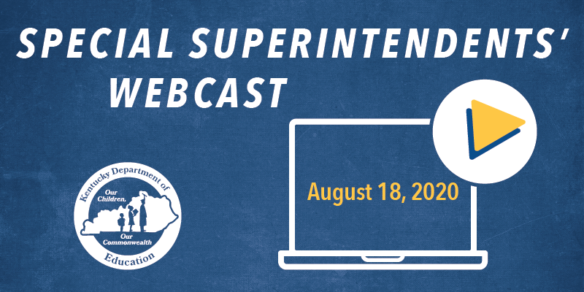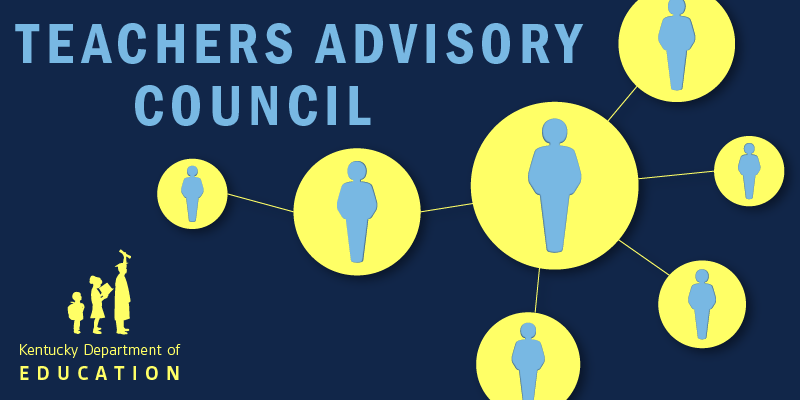
By Jim Gaines
jim.gaines@education.ky.gov
Kentucky’s public health commissioner discussed COVID-19 case reporting and the latest statistics with the state’s school superintendents during the Aug. 18 Special Superintendents’ Webcast.
Dr. Steven Stack, commissioner of the Kentucky Department for Public Health (DPH), addressed questions about the data and testing, which he said has changed greatly since June when the Kentucky Department of Education (KDE) and DPH released their flagship Healthy at School guidance in June.
He said he knows difficulties with data are frustrating for superintendents, but DPH is working hard on improving and automating the reporting system.
“We have come a long way. The data has gotten much better over time,” Stack said.
But he said there are “many, many reasons why collecting this data on which we all rely is difficult.”
Under normal circumstances labs only report positive results, not the total number of tests given, he said. When the reporting system was created, gathering all test results wasn’t practical because that was before the advent of electronic reporting, Stack said. Data still arrives in a variety of formats and it’s very labor-intensive for DPH personnel to enter them all into one database, he said.
Since positive COVID-19 tests may take several days to come in, those results don’t line up with the number of tests given on a particular day. Also, people may not live or work in the county where they’re tested, potentially skewing local results, Stack said.
The magnitude of this pandemic has prompted many places which previously didn’t do disease testing, such as nursing homes, to begin doing so. While that has increased Kentucky’s testing capacity, it also means many places now processing tests are unfamiliar with reporting requirements and methods.
Stack said that COVID-19 cases in the United States are far higher than in other countries as a percentage of population, which makes controlling outbreaks and reopening schools much harder.
“You can do things when the disease is very rare, or uncommon, that you can’t do when it’s exploding all around you,” he said.
Kentucky’s “enormous accomplishment” was holding new cases at a plateau for three months, but numbers began climbing in early July. Following Gov. Andy Beshear’s announcement of new restrictions on Aug. 10, cases seem to have leveled off again – but at a rate three times higher than before, Stack said. If that rate doesn’t come down, he said it could easily get out of control, leading to a wave of deaths such as New York experienced last spring.
The Healthy at School guidance, predicated on June’s lower positivity rate, should be considered the minimum standard for the entire coming academic year, Stack said. If infections climb further, he said tighter restrictions will be needed.
Stack said a COVID-19 vaccine should not be expected this year. Even if one becomes available early in 2021, he said it still will be months before much of the population can be vaccinated.
Lt. Gov. Jacqueline Coleman said even the best school reopening plans, if done at the wrong time, will be unsuccessful. Other states, even ones which haven’t reopened schools yet, have hundreds or thousands of families in quarantine.
When schools close for outbreaks of other diseases like the flu, they don’t wait for children to start dying before shutting down, Coleman said. She also noted the long-term effects of COVID-19 on young people are still poorly understood but “very troublesome,” including lasting organ damage.
No current option for opening or delaying school is ideal, but districts will have to pick the best they can, Coleman said.
Small Group Guidance
KDE released guidance on Aug. 17 on allowing small groups of students back into school buildings for specific purposes such as evaluations, required hands-on work, counseling, therapy and tutoring.
Before deciding to reopen for small groups, school officials should think about whether they can accomplish the same goal virtually, said Kelly Foster, KDE associate commissioner in the Office of Continuous Improvement and Support. If it is necessary to bring students in, they must follow the Healthy at School guidance on temperature checks, social distancing, mask wearing, sanitization and contact tracing. No building can hold more than 15% of its usual student building capacity, and no room can have more than 10 people at once, including the teacher, Foster said.
Some services make in-person instruction necessary, especially for students that have Individualized Education Programs, said Gretta Hylton, KDE associate commissioner in the Office of Special Education and Early Learning. In planning for that, she said schools should review the July 20 guidance on exceptional learners and preschool students, which includes relevant information.
Admissions and release committees still are responsible for determining what services are necessary for a free, appropriate public education, Hylton said. Some of those must be in person, but if health risks are too great, school districts should plan to deliver compensatory education later.
Participation Tracking
Guidance on tracking student participation online in the Infinite Campus system also was released on Aug. 17. Schools are not required to collect attendance data this year, since most learning will be through non-traditional instruction (NTI), but they still must track daily participation, said Caryn Davidson, KDE academic program consultant in the Office of Teaching and Learning.
The update comes after a document on daily participation and NTI was released earlier this year, which led to questions on how to set up online courses and participation tracking, Davidson said.
Early Opening Consequences
Interim Commission of Education Kevin C. Brown addressed a question he’s been asked repeatedly since Gov. Beshear recommended that schools delay opening for in-person classes until Sept. 28: What are the consequences for districts if they reopen before then?
Brown said he had calls from 20 of the state’s 171 school districts over the previous four days, and repeated his earlier answer to all of them.
The “consequences” of going against Gov. Beshear’s recommendation are those of public health – the likelihood of increased COVID-19 cases. That means districts which open early may have to shut down due to an outbreak, Brown said.
KDE officials would not show up to shut schools down.
The department is asking districts to follow the Healthy at School guidance, but KDE has neither approved nor disapproved any district reopening plans, he said.
Brown described all 20 phone calls as non-confrontational, and said the districts had good reasons for wanting to reopen. But the decisions lie in weighing one set of public health factors against another, he said.
Some districts he spoke to said they will continue examining the timing of their reopening schedule, or will offer hybrid learning with a choice of online or in-person classes, Brown said. But most of the 20 still were planning to open before Sept. 28.
Asked whether Gov. Beshear is likely to order schools to close, Brown said he couldn’t speak for the governor, but the health situation changes daily. If districts choose to open before Sept. 28, they need to watch their local case counts closely and perhaps revisit their decision if the number of cases starts to increase, he said.
MORE INFO …
- Aug. 18 Special Superintendents’ Webcast
- KDE’s COVID-19 webpage
- KDE’s COVID-19 Reopening Guidance webpage
- Kentucky COVID-19 Hotline (800) 722-5725



Leave A Comment